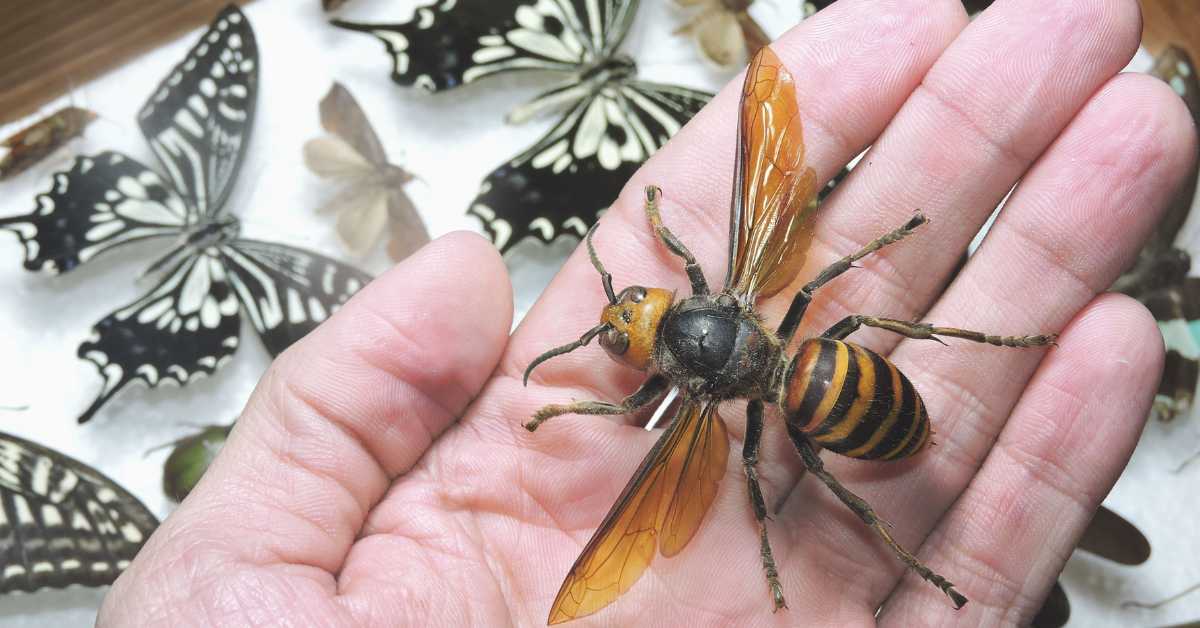The Asian giant hornet, or Vespa mandarinia, in the United States, has left many people asking a burning question: “How many people each year die from Giant Asian Hornet attacks?” In truth, while the giant hornet possesses a formidable sting, the media portrayal of these insects as ‘murder hornets’ often tends to inflate the level of risk for the average person.
What are Giant Asian Hornets?
Often labeled as the world’s largest hornet, the Asian giant hornet measures about 2 inches long, with a robust body, large head, and a conspicuous, club-shaped antenna. Their diet primarily consists of insects, sap, and honey from honey bee nests. Asian giant hornets are especially notorious for their predatory behavior toward honey bees, hence their ominous nickname ‘murder hornet.’
How many people die from Asian giant hornet stings?
Although giant hornet stings can indeed be fatal to humans, especially those with allergies, the actual number of fatalities is relatively small. In Japan, one of the native habitats of the Asian giant hornet, an average of 12 to 50 people die each year due to their stings. These deaths are often a result of multiple stings leading to anaphylactic shock, cardiac arrest, or organ failure, rather than a single sting.
Where are they located?
Asian giant hornets are native to temperate and tropical areas of Eastern Asia, including Japan, China, India, and the mountains of Nepal. In their native habitats, they play an important role in the ecosystem by controlling pest populations. Their presence in the United States was first confirmed in Washington State by the Washington State Department of Agriculture in 2019, sparking concern over their potential impact on honey bees and local ecosystems.
How to protect yourself
To protect yourself from a potential giant hornet sting, you should:
- Stay clear of any suspected hornet nest. Their nests can often be found in tree cavities or underground.
- Do not swat at them. Rapid movements can provoke the hornet.
- Seek immediate medical help if stung multiple times or if an allergic reaction occurs.
Understanding the ‘Murder Hornets’
Understanding these ‘murder hornets’ requires a closer look at their behavior, impact on honey bees, and the role of pest management in controlling their spread.
The Behavior of Asian Giant Hornets
Asian giant hornets, unlike some other hornet species, are not typically aggressive towards humans unless provoked or their nest is disturbed. Their hunting focus largely remains on other insects, mainly honey bees, to fulfill their protein needs.
Impact on Honey Bees
The major concern about having Asian giant hornets in the United States is their potential threat to the already declining honey bee population. In their native habitat, they’ve been observed to wipe out entire honey bee colonies within hours, thus potentially disrupting pollination and honey production.
Role of Pest Management
Efforts by the Washington State Department of Agriculture and local pest management services have been aimed at tracking and eradicating Asian giant hornet nests to prevent their spread. Citizen scientists also play a crucial role in reporting suspected sightings of this invasive species.
How many times can an Asian Giant Hornet Sting?
Contrary to bees, which die after stinging once, an Asian giant hornet can sting multiple times. Their stingers, lacking barbs, do not get lodged in their victim, allowing them to deliver repeated stings. Each sting injects a potent venom that can cause severe pain and possible allergic reactions.
How many times do you have to get stung by a hornet to die?
There isn’t a definitive answer to this question as it largely depends on an individual’s health condition and response to the venom. In general, a single sting from an Asian giant hornet isn’t deadly to humans unless they’re allergic. However, multiple stings increase the risk of severe reactions and potentially death, especially if medical help isn’t sought immediately.
What is the risk of being stung?
The risk of being stung by an Asian giant hornet is relatively low unless you are in close proximity to their nest or provoke them. With their current restricted distribution in North America, the majority of the United States population has little to worry about.
What parts of the United States have Asian Giant Hornets?
Currently, Asian giant hornets have been identified primarily in Washington State and the nearby British Columbia in Canada.
Confirmed Sightings
Most of the confirmed sightings and nests eradicated have been in the northern part of Washington State, near the Canadian border.
Potential Spread
Given their recent introduction, it’s still unclear how quickly and extensively the Asian giant hornets might spread within the United States.
Response and Control
The Washington State Department of Agriculture, with aid from citizen scientists, continues to monitor and control the spread of these hornets, utilizing trapping, tracking, and eradication strategies.
Conclusion
While it’s true that the Asian giant hornet can be a danger to humans and honey bees, their fearsome reputation as ‘murder hornets’ tends to be overblown. As for the question, “How many people each year die from Giant Asian Hornet attacks?”, the number remains relatively low, especially in North America where the hornets are not widespread. Vigilance and prompt reporting of any suspected sightings can aid in the control and management of this invasive species, safeguarding both our health and the health of our crucial honey bee populations.

